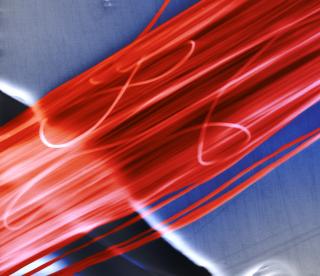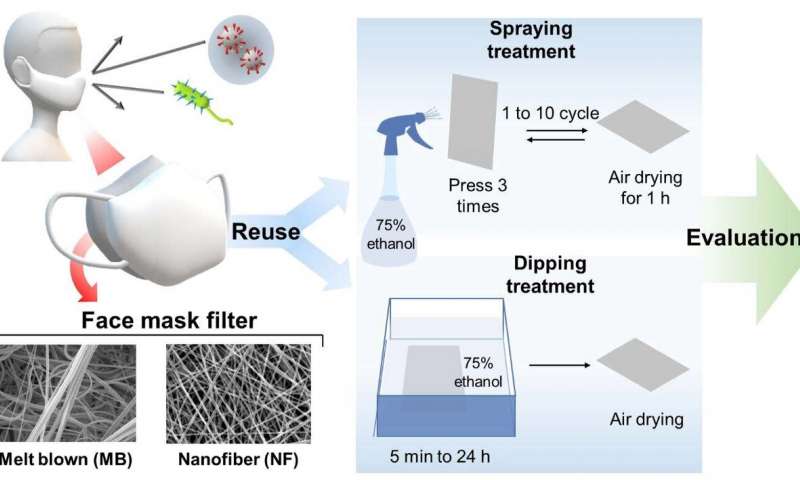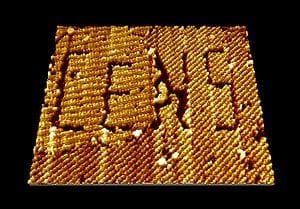
They discovered that by making the nanofiber thinner than had been done before, it became not only stronger, as was expected, but also tougher.
University of Nebraska-Lincoln materials engineers have developed a structural nanofiber that is both strong and tough, a discovery that could transform everything from airplanes and bridges to body armor and bicycles. Their findings are featured on the cover of this week’s April issue of the American Chemical Society‘s journal, ACS Nano.
“Whatever is made of composites can benefit from our nanofibers,” said the team’s leader, Yuris Dzenis, McBroom Professor of Mechanical and Materials Engineering and a member of UNL’s Nebraska Center for Materials and Nanoscience
“Our discovery adds a new material class to the very select current family of materials with demonstrated simultaneously high strength and toughness.”
In structural materials, conventional wisdom holds that strength comes at the expense of toughness. Strength refers to a material’s ability to carry a load. A material’s toughness is the amount of energy needed to break it; so the more a material dents, or deforms in some way, the less likely it is to break. A ceramic plate, for example, can carry dinner to the table, but shatters if dropped, because it lacks toughness. A rubber ball, on the other hand, is easily squished out of shape, but doesn’t break because it’s tough, not strong. Typically, strength and toughness are mutually exclusive.
Dzenis and colleagues developed an exceptionally thin polyacrilonitrile nanofiber, a type of synthetic polymer related to acrylic, using a technique called electrospinning. The process involves applying high voltage to a polymer solution until a small jet of liquid ejects, resulting in a continuous length of nanofiber.
They discovered that by making the nanofiber thinner than had been done before, it became not only stronger, as was expected, but also tougher.
Dzenis suggested that toughness comes from the nanofibers’ low crystallinity. In other words, it has many areas that are structurally unorganized. These amorphous regions allow the molecular chains to slip around more, giving them the ability to absorb more energy.
Most advanced fibers have fewer amorphous regions, so they break relatively easily. In an airplane, which uses many composite materials, an abrupt break could cause a catastrophic crash. To compensate, engineers use more material, which makes airplanes, and other products, heavier.
“If structural materials were tougher, one could make products more lightweight and still be very safe,” Dzenis said.
Body armor, such as bulletproof vests, also requires a material that’s both strong and tough. “To stop the bullet, you need the material to be able to absorb energy before failure, and that’s what our nanofibers will do,” he said.
The Latest Bing News on:
Nanofibers
- 3 Body Problem: Where the universe holds bareon April 26, 2024 at 10:00 pm
Netflix's adaptation of '3 Body Problem' turns Liu Cixin's science fiction trilogy into a visually stunning, intellectually provocative series that explores the limits of human knowledge and the compl ...
- Nanofibers Rid Water of Hazardous Dyeson April 25, 2024 at 1:46 am
Dyes, such as those used in the textile industry, are a major environmental problem. At TU Wien, efficient filters have now been developed – based on cellulose waste.
- Nanofibers rid water of hazardous dyes: Researchers develop efficient filters based on cellulose wasteon April 24, 2024 at 8:21 am
Using waste to purify water may sound counterintuitive. But at TU Wien, this is exactly what has now been achieved. Researchers have developed a special nanostructure to filter a widespread class of ...
- Lithium Silicon Battery Market Set to Skyrocket, Projected to Reach US$ 1150.0 Billion by 2034, with a CAGR of 48.4%on April 23, 2024 at 8:34 pm
The market is expected to reach a valuation of US$ 1150.0 billion by 2034. The lithium silicon battery market is rising due to the EV.
- Unconventional technology enhances composites important to automotive, aerospace and renewable energy industrieson April 23, 2024 at 1:08 pm
Scientists at the Department of Energy's Oak Ridge National Laboratory have developed a method that demonstrates how fiber-reinforced polymer composite materials used in the automotive, aerospace and ...
- Separating science fact from fiction in Netflix’s ‘3 Body Problem’on April 23, 2024 at 6:00 am
In 3 Body Problem, an alien race called the San-Ti inhabits a planet in a triple star system four light-years from Earth. The stars’ unpredictable orbits lead to “stable” and “chaotic” eras. Chaotic ...
- Ocean environment safety of nanocellulose investigated in study of musselson April 17, 2024 at 12:45 pm
Cellulose nanofibers represent a promising resource for multiple industrial sectors, but what is their impact on the marine environment? A study published in Environmental Science: Nano recently ...
- Saudi Arabia Nanofibers Market Scope, Trends, Size, Share, Prominent Players and Forecast to 2024 to 2032on April 15, 2024 at 4:33 pm
Request To Download Free Sample of This Strategic Report @ The publisher has been closely monitoring the various markets in Saudi Arabia. This report provides a comprehensive analysis, detailing ...
- How ‘3 Body Problem’ Gets Lost in Translationon April 12, 2024 at 11:43 pm
The most notable exception may be Liu Cixin’s novel The Three-Body Problem, the sci-fi phenomenon whose 2014 English translation earned the Hugo Award and an endorsement from President Barack Obama.
- Chung, Govindaraju, Murphy to receive UB President’s Medalon April 11, 2024 at 5:38 am
The UB President's Medal recognizes extraordinary service to the university. UB faculty members Deborah Duen Ling Chung, Venu Govindaraju and Timothy Murphy are this year’s recipients of the UB ...
The Latest Google Headlines on:
Nanofibers
[google_news title=”” keyword=”nanofibers” num_posts=”10″ blurb_length=”0″ show_thumb=”left”] [/vc_column_text]The Latest Bing News on:
Structural nanofiber
- Feed has no items.
The Latest Google Headlines on:
Structural nanofiber
[google_news title=”” keyword=”structural nanofiber” num_posts=”10″ blurb_length=”0″ show_thumb=”left”]










